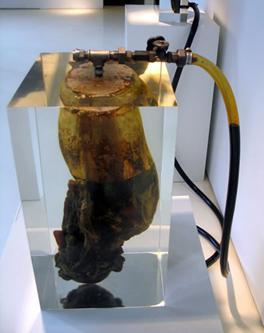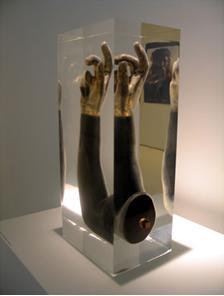“Sweet Crude Eternity”: Andrei Molodkin at Kashya Hildebrand
Andrei Molodkin, December 8-January 21 2006, Kashya Hildebrand Gallery, New York
 Andrei Molodkin’s most recent exhibition reveals some highly charged works which poignantly unmask the political intrigue that is often not far from the surface of the global oil business. By throwing together so directly the forces of culture and politics, Molodkin’s sculptures draw the viewer to reflect not only on their effect upon humanity and the environment in which we live, but also on their potential for the diminution of culture as a whole.
Andrei Molodkin’s most recent exhibition reveals some highly charged works which poignantly unmask the political intrigue that is often not far from the surface of the global oil business. By throwing together so directly the forces of culture and politics, Molodkin’s sculptures draw the viewer to reflect not only on their effect upon humanity and the environment in which we live, but also on their potential for the diminution of culture as a whole.
At the heart of this exhibition is Molodkin’s exploration of the concepts of consumption and economy exemplified by a series of sculptures filled with unprocessed crude oil. The artist draws parallels between blood and oil, which circulates through the human body, feeding the brain and nourishing life. Likewise, oil runs through the earth’s entrails, feeding engines and ensuring communication.
 Oil suffuses the sculptures’ hollow spaces, consuming their transparent bodies. This ‘black magic’ is juxtaposed with the off-white color of silicon and polyester resins, the principle medium of Molodkin’s sculptures. This dichotomy conjures up baroque and theatrical associations, and it leaves one wondering as to how both materials can coexist.
Oil suffuses the sculptures’ hollow spaces, consuming their transparent bodies. This ‘black magic’ is juxtaposed with the off-white color of silicon and polyester resins, the principle medium of Molodkin’s sculptures. This dichotomy conjures up baroque and theatrical associations, and it leaves one wondering as to how both materials can coexist.
Molodkin attempts to heighten the monumental qualities of his sculptures by casting them in the manner of classical figures such as the Nike of Samothrace, Apollo, Venus, and Christ, filling their bodies with oil collected from the pipelines of national corporations. By so doing the artist creates sculptures that could be described as ‘liquid monuments’ to the triumph of the economy over culture.
Because the oil quickly evaporates each sculpture is connected through a pipeline to a cistern with oil that is continuously refilled. A slight odor of oil vapor pervades the gallery space. The scent contributes to the installation’s ‘totality’ effect which invades and breaks up the gallery with sequences of oil cisterns situated next to the ‘profundities’ of classical sculptures. These effects combined with the oscillating level of liquid in the sculptured bodies reinforce the sculpture’s transient character.
Molodkin ‘embodies’ the goddess figures with oil and with the power that oil signifies, implying a parallel between the ‘flammable,’ and corrupt character of both oil and power as a relentless source of conflicts. Molodkin implies that the politics of the distribution of oil and the conflicts that result from these could be compared to the ‘religious wars’ of medieval times, which in the modern era have been resurrected in the name of a god called ‘Oil…’
Molodkin is aware of the vanity of signs, gods and commodities. This can be gleaned from the re-occurring theme of the human skull which he obsessively draws as a powerful motif on his earlier canvases. Corresponding to this, in the current exhibition, he cast the negative shape of a human skull in transparent silicon and attached a pipeline to its throat aperture. The pipeline functions as a substitute for the body and a reference to oil as the ‘global blood’.Andrei Molodkin in conversation with Victor and Margarita Tuptsyn, Exhibition catalogue, Kashya Hildebrand Gallery, New York, 2005, 3.
By pumping oil through the human brain and heart the artist reflects on the crucial necessity and omnipresence character of petroleum in everyday life, but he also refers to the superficiality of human nature, which is relentless in its pursuit of oil for economic wealth and profit.
The pipes, switches, knobs and cisterns which are placed next to each sculpture constitute an inseparable part of each installation, regardless of their ‘crude’ materiality and seemingly obtrusive presence. By including oil containers and tubes in the exhibition, the artist claims that every process of creation originates in something very organic and essential, which feeds the economy, like oil, in the same way the body is nourished by blood.
 In another group of sculptures presented at the exhibition, Molodkin employs Christian imagery, such as the body and head of Jesus, and a hand configured in a gesture of blessing. These sculptures have been produced by a laborious process of inserting wax molds into an acrylic block. The wax eventually melted under the heat and pressure, leaving behind negative spaces.
In another group of sculptures presented at the exhibition, Molodkin employs Christian imagery, such as the body and head of Jesus, and a hand configured in a gesture of blessing. These sculptures have been produced by a laborious process of inserting wax molds into an acrylic block. The wax eventually melted under the heat and pressure, leaving behind negative spaces.
The preservation of Molodkin’s sculptures is a difficult problem, for a number of reasons that range from oil supply to the fumes they emit and the risk of fire.
On a more formalist level, the rich materiality of Molodkin’s sculptural forms could be described as baroque and opulent, a fact that is accentuated by the warmth and transparency of silicon cubes and the weight and density of oil.
The polyester cubes which envelop the sculptures add strength to the monumental aspect of the works, which have an overall average size of 1 meter by 0.5 meter. They also hint at the museum or gallery in which they are displayed, alluding to the question as to how these objects should be displayed.
Oil evokes an association with industrial disasters, such as oil leaks and slicks. The danger, mystery and global consequences of such environmental calamities and the ‘domestic’ and ‘tamed’ look of oil containers in a gallery space incite thoughts of the ‘gothic’ disquiet of a global disaster.
Molodkin’s ‘oil mythology’ speaks to us about possible future catastrophes, the cruelties of wars, and fortunes to be made. It does so in a language that analyzes not only the immediacy of economic power but also the way in which that power affects what we call art.




